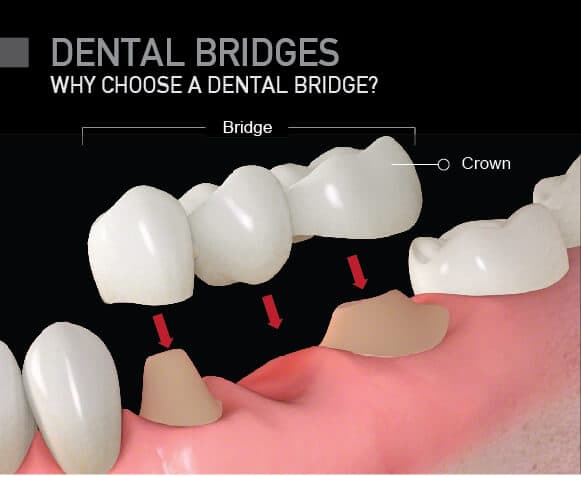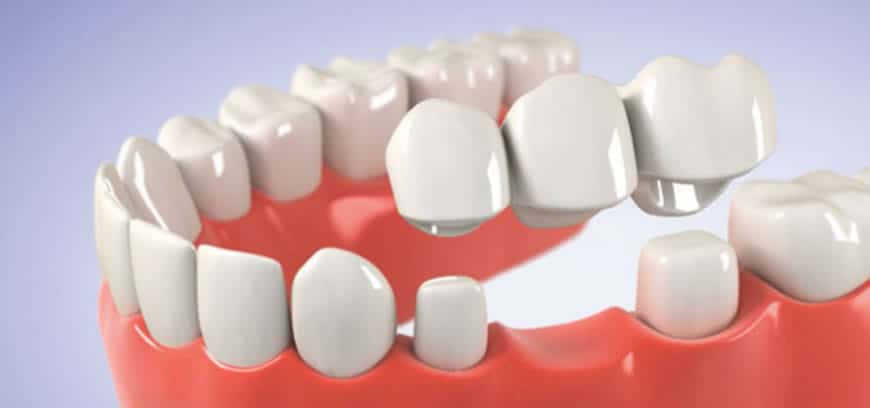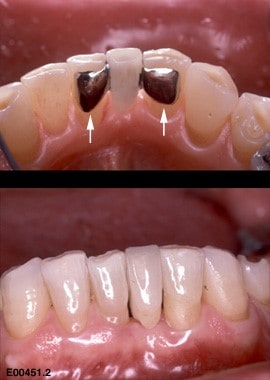

Teeth bridges are literally a bridge connecting and filling a gap in your mouth with false teeth which are cosmetically matched to your current teeth. Bridges are a permanent fitting so you can’t remove them for cleaning like dentures.

Bridges cannot be flossed in the usual way as they are firmly attached to the supporting teeth on either side of the bridge. However, keeping the bridge clean is very important so there is a specially designed dental floss, manufactured for anyone who has a bridge.
One side of the floss has a firmer plastic end which can be threaded underneath the bridge and pulled through so the thicker element of the floss rests on the gum underneath the bridge. Once in place, this floss can be moved around along the underside of the bridge to remove food debris and any plaque that has accumulated. It is essential to do this regularly to help prevent gum disease and the build-up of decay around what is called the abutment teeth – the teeth at either end which support the bridge.

Most bridges will last a good ten years with the benefit of regular cleaning and dental check ups, some a lot longer. The key to longevity is a proper planned procedure carried out by a professional dentist and then regular aftercare and check-ups.

Theoretically, a bridge can contain any number of teeth but the average is three or four. The decision on the number of teeth in the bridge and whether a bridge is the most suitable option will depend upon a number of factors including the patient’s bite, build, age and the condition of the neighbouring teeth.
Adhesive bridges tend to be smaller and recommended for one tooth only but conventional bridges can have a wider span of teeth. Each patient is unique and a full and careful evaluation needs to be made by the dentist.

A bridge can restore a person’s smile and also hugely increase confidence which is often severely dented if one or more teeth are visibly missing from the mouth. Absent teeth can also affect speech and the ability to chew both of which can be restored with this form of cosmetic dentistry. Missing teeth can affect the shape of the face and change the bite which is the way the jaws come together. So although a dental bridge is deemed to be cosmetic, it can actually have a huge influence over the mechanics of speech, eating and general jaw movement.
The initial appointment will evaluate the patient’s mouth and discuss the suitability of a bridge or whether other alternatives like dental implants may be more appropriate. The abutment teeth are prepared through a process called recontouring; this involves removing some of the enamel to accommodate a crown which will be placed over the top for the bridge to fit on to. Then impressions are made for the teeth which act as a model for the bridge. The dentist will make a temporary bridge to protect the exposed teeth whilst the permanent bridge is made in a dental laboratory.
On a second visit, the temporary bridge is removed and the new porcelain or metal bridge fitted and adjusted as necessary. There may be several follow up visits to check the fit of the new bridge as it settles down.
Due to the advances in dental materials including dental cement, it is now possible to fit a bridge using a bonding adhesive rather than altering the structure of the adjacent teeth and fitting a crown. This type of bridge is called an adhesive bridge and has wings on either side of the false tooth or teeth which are bonded onto the back surfaces of the adjacent abutment teeth. The main advantage with adhesive bridges is that they require little or no preparation so they are quicker and also avoid the need for any alterations to be made to the existing teeth.
Adhesive bridges are not suitable for every person and can only be used in specific circumstances. They rely on having good quality and strong teeth to bond to so if the adjacent teeth are heavily filled, then they may not be a good candidate for this type of bridge.


Theoretically, any teeth can be replaced with a bridge but front teeth are usually easier than back teeth.
Teeth bridges can stain just like regular teeth with dark liquids like tea and coffee and red wine so avoiding these beverages or minimising them will help to protect the colour on a new bridge.
The teeth in a bridge are made of porcelain generally but not always, some are made of metal. Porcelain can be stained dark by acidic foods and liquids so the best option is to ask a dental professional to clean the bridge and the rest of the teeth during an appointment at the clinic. Artificial teeth cannot be whitened or lightened like regular teeth and sometimes this is the trigger for some people to have a new bridge fitted if they have had their existing bridge for a long time.
The answer to that question will vary according to the individual and reflect all the different criteria a dentist will consider when recommended corrective or cosmetic treatment. These include:-
